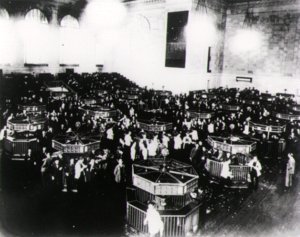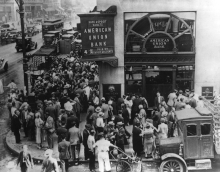Black Thursday

Black Thursday ( English Black Thursday ) is a term for October 24, 1929 and the associated most momentous stock market crash in history. After a significant decline in the Dow Jones Index , which had been rising sharply for years, had already been recorded in the previous weeks , panic broke out among investors that day . The stock market prices fell sharply, many investors were heavily in debt after the market closed.
The crash dragged on for days. On Black Tuesday (English Black Tuesday , October 29) tried simultaneously to sell their shares all investors. This stock market crash is considered to be the trigger for the Great Depression in the USA and the global economic crisis . The following bear market did not reach its final low until 1932.
Designations
The same event is often referred to as Black Friday in Europe . This is often justified by the fact that, due to the time difference, the news of the crash in America did not arrive until after the stock exchanges in Europe had closed in the evening and therefore did not lead to panic on the European stock markets until the next day .
Two years earlier, on Friday, May 13, 1927, there had suddenly been a sharp slump in the share index of the Reich Statistical Office on the Berlin stock exchange , which is also known as Black Friday . In the United States , Black Friday describes the stock market crash of September 24, 1869.
The inception of the crash on Oct. 29, 1929 is often perceived that Black Tuesday (English Black Tuesday ). This Black Tuesday in particular has become proverbial in the English-speaking world .
prehistory
This was preceded by a speculative bubble . In the 1920s, an apparently unstoppable bull market had driven the Dow Jones up to 331 points - in 1923 it was still around 100. One spoke of an "eternal prosperity" - an eternal prosperity. Not only large investors and companies speculated in this misjudgment of the situation, numerous small investors also risked a lot; Millions took out large short-term loans to buy shares (often the shares alone were considered security) in the hope of being able to repay them with the profits . A stock exchange supervisory authority and many regulation laws that are taken for granted today did not yet exist.
There were warnings in advance (e.g. from Roger Babson ) that were dismissed as black paint. The majority of business leaders and scientists were still convinced in mid-October that the soaring would go on forever. Economics professor Irving Fisher announced on October 16: "It looks like stocks have reached a permanent high plateau." When the Dow Jones fell sharply in October 1929, nervousness broke out: many began to realize how high the risk they had taken was. By October 19, the Dow Jones had lost 15 percent; Banks and investment firms began support purchases .
collapse

Small investors became vaguely aware of the danger in mid-October. The prices were still at a high level, but they stagnated . Many realized that this way they would not be able to repay their loans. The inflow of capital collapsed, the trading volume increased significantly. The entire week before the actual collapse was hectic and fearful. Brokers worked late into the night and the police cordoned off the area around the New York Stock Exchange as a precaution . On October 23, the Dow Jones was just over 300 points.
On October 24, 1929, the nerves of many traders were on edge. Still, trading began quietly. At around 11 a.m. that changed suddenly - without any clearly recognizable trigger. One possible trigger, however, was the bankruptcy of the London speculator Clarence Hatry , because British capital was withdrawn from Wall Street because of him. Massive sales drove prices into a nosedive. In a panic, many traders were ordered to sell at any price, the trade collapsed several times. Two hours later, the total value of listed companies had fallen by $ 11 billion , roughly 1.5% of the US annual gross national product at the time.
The banks tried to calm the mood with the help of soothing reports and massive support purchases. Richard Whitney , then Vice-President and later President of the New York Stock Exchange, appeared in person on her behalf and on that of the Board of Directors and ordered a number of shares, especially those of top-quality stocks above the current market price. His performance earned him some fame. This was initially successful, trading closed with a loss of just 2.1% at 299 points. Over 13 million shares had been traded, more than four times as many as on a normal day.
The British Chancellor of the Exchequer and later Prime Minister Winston Churchill happened to be visiting the New York Stock Exchange that day. In his memoirs there is a vivid description of this fateful day for Western societies.
The trend continued unchanged on Friday . The news had now reached the European stock exchanges, but the European securities markets initially reacted rather optimistically to the collapse of the huge speculative bubble on the New York Stock Exchange. It was expected that American lenders would lend their money back to Europe in the future instead of investing it on Wall Street, as in the previous year and a half. The US banks tried to support the market and even achieved a small plus on that day, despite a trading volume of 8 million shares and price losses of individual shares of up to 30%.
The market did not finally collapse until the following Tuesday. The prices had fallen too far to be able to cover the loans - the banks were now demanding their money back and often forced investors to sell the stocks they had deposited as collateral. This now ensured massive sales at any price, the trading volume continued to rise, the Dow Jones fell to 260 points. The prices continued to spiral down, and the market value of the companies fell another $ 14 billion. On the following Tuesday, the trading volume even grew to 16.5 million, some stocks had fallen by 99%. Some investors took their own lives. Nevertheless, there is no historical evidence that there was a wave of suicide after the crash. John Kenneth Galbraith even demonstrated in his well-known work "The Great Crash 1929" that the number of suicides in October and November 1929 was significantly lower than in the summer months when the stock market was still booming.
consequences


The courses fell for another three weeks. It was not until November 15 that a sideways movement set in, with the Dow Jones standing at around 180 points. Some now believed that the low point had been reached and bought the supposedly cheap stocks again at high risk. But prices continued to fall, and it wasn't until the summer of 1932 that the bottom was reached at 41 points - the same value as on May 26, 1896, when the Dow Jones index was first published .
Many investors were left heavily in debt, with also many companies that are now bankrupt had to file. Other firms had backed loans with their own stocks and were also in trouble. This led to mass layoffs and unemployment spread. The acute losses of capital, but above all the loss of confidence among investors, made economic recovery difficult.
The money shortage of over 30% caused by the Fed after Black Thursday led to a further worsening of the crisis and is being used by economists such as B. the Alfred Nobel commemorative laureate for economics Milton Friedman , analyzed as a catalyst for the subsequent depression.
In Europe, the stock markets also collapsed, many assets were destroyed and companies had to give up. Most countries still had debts in the United States from the First World War, which have now withdrawn their money. The world economic crisis set in. America was hit hardest by far, measured by gross national product , which plummeted by 28% during this period.
Germany, still heavily indebted from the First World War and heavily burdened by the Treaty of Versailles , was hit the second hardest. Heinrich Brüning's government relied on a tough austerity policy; demand collapsed and deflation arose. Unemployment grew to over 30 percent by 1933, more than the United States suffered during the crisis. After the hyperinflation that had just been overcome (see German inflation 1914 to 1923 ), a serious crisis had set in again, and extremist parties achieved electoral successes. The global economic crisis is only considered over in 1933, when Adolf Hitler was already in power.
The confidence of small investors in the financial markets in particular was permanently shaken. It was not until the 1970s that this group brought relevant amounts of money back onto the stock exchange. But the large investors were also shocked; it was not until 1954 that the Dow Jones peaked again for the first time.
Not only the stock market crash itself, but also its history and of course the question of guilt called critics of the "old guard" on the scene, by which the wealthy members of the stock exchange and brokers were meant, above all Richard Whitney, who has now risen to their presidency. In an effort to create laws that would regulate speculation in the future and prevent a repetition of the stock market crash, Congress set up a committee of inquiry, to which Whitney, among others, had to testify several times between 1932 and 1935.
Based on the experience of Black Thursday, all stock exchanges later issued rules that temporarily suspend trading in the event of an extreme price decline in order to curb the resulting panic. In addition, there were further restrictions, for example for credit financing for stock transactions. Subsequent stock market crashes were therefore less dramatic than Black Thursday.
Other stock market crashes
- Black Monday (1987)
- Black Friday (multiple crashes)
literature
- Fritz Blaich: Black Friday. Inflation and the Great Depression. Deutscher Taschenbuch-Verlag, Munich 1985, ISBN 3-423-04515-9 ( German history of the latest time - dtv. 4515).
- John Kenneth Galbraith : The great crash of 1929. Causes, course, consequences. FinanzBook-Verlag, Munich 2005, ISBN 3-89879-054-1 .
- Charles P. Kindleberger : The Great Depression . 1929-1939. Deutscher Taschenbuch-Verlag, Munich 1973, ISBN 3-423-04124-2 ( History of the World Economy in the 20th Century. Vol. 4 = dtv 4124 Scientific Series ).
- Maury Klein : Rainbow's End: The Crash of 1929. Oxford University Press, New York 2003, ISBN 978-0-1951-5801-4 .
- Barnie F. Winkelmann: Ten Years of Wall Street. Fraser Publishing, Burlington VT 1987, ISBN 0-87034-082-4 .
Web links
- Greed and trust in God. , Hans Evert on: welt.de , October 23, 2004.
- Missing Link: The black days - 90 years ago the world plunged into crisis , Detlef Borchers on: heise.de , November 3, 2019
Individual evidence
- ↑ http://www.independent.co.uk/news/business/analysis-and-features/history-lessons-galbraiths-the-great-crash-1929-is-still-essential-reading-today-956710.html
- ↑ Milton Friedman: A Monetary History of the United States 1867-1960. Princeton Univ. Pr., 1971, ISBN 0-691-00354-8 .